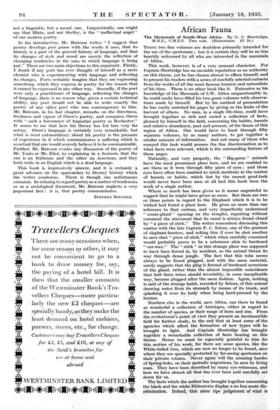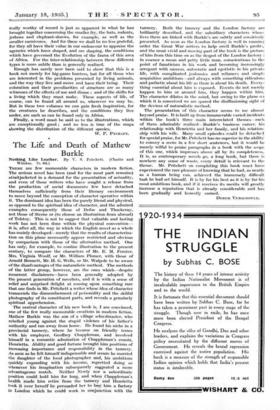African Fauna
THESE two fine volumes are doubtless primarily intended for the use of the sportsman ; but it is certain they will be no less heartily welcomed by all who are interested in the mammals of Africa.
This work, however, is of a very unusual character. For Captain Shortridge has an enviable reputation as an authority on this theme, yet he has chosen almost to efface himself, and to present his readers with a series of carefully selected extracts from the works of all the most famous hunters and naturalists of his time. There is no other book like it. Extensive as his knowledge of the Mammals of S.W. Africa unquestionably is, he could easily have filled his two great volumes with observa- tions made by himself. But by his method of presentation he has vastly enriched his pages by giving us the fruits of the harvest of others. No man, in a single life-time, could have brought together so rich and varied a collection of facts, gleaned by himself in the field, concerning the habits, haunts and relative abundance, past and present, of the fauna of this region of Africa. One would have to hunt through fifty separate volumes, by as many authors, to get together a similar amount of information. And not many of those who essayed this task would possess the fine discrimination as to what facts were relevant, which is the outstanding feature of these pages.
Naturally, and very properly, the " Big-game " animals have the most prominent place here, and we are enabled to see them as it were through fifty pairs of eyes ; and those eyes have often been enabled to catch incidents in the matter of haunts or habits, which but by the merest good-luck would never have been seen at all had this book been the work of a single author.
Where so much has been given us it seems ungrateful to suggest that he might have given us more. But there are two or three points in regard to the Elephant which it is to be wished had found a place here. He gives no more than one reference to that curious, and very imperfectly imderstood " sweat-gland " opening on the temples, repeating without comment the statement that its canal is always found closed by " a piece of stick." The writer remembers discussing this matter with the late Captain F. C. Selous, one of the greatest of elephant-hunters, and asking him if ever he shot another to save that " piece of stick," which when carefully examined would probably prove to be a substance akin to hardened " ear-wax." The " stick " in this strange place was supposed to have been forced in, by accident, as the animal thrust its way through dense jungle. The fact that this tube seems always to be found plugged, and with the same material, surely suggests that the plug is formed of hardened secretions of the gland, rather than the almost impossible coincidence that both these tubes should invariably, in some inexplicable way, become plugged after the same fashion. Again, nothing is said of the strange habit, recorded by Selous, of this animal drawing water from its stomach by means of its trunk, and splashing it over its body when being hard-preised by the hunter.
Nowhere else in the world, save Africa, can there be found so wonderful a collection of Antelopes, either in regard to the number of species, or their range of form and size. From the evolutionist's point of view they present an inexhaustible field for further study, to the end that at least some of the agencies which affect the formation of new types will be brought to light. And Captain Shortridge has brought together a remarkable collection of facts bearing on this theme. Hence we must be especially grateful to him for this section of his work, for there are some species, like the White-tailed Gnu, which are now no longer to be found, save where they are specially protected by far-seeing sportsmen on their private estates. Never again will the amazing hordes of Spring-boks, on their sporadic migrations, be seen by living man. They have been described by many eye-witnesses, and here we have almost all that has ever been said carefully set down for us.
The facts which the author has brought together concerning the black and the white Rhinoceros display a no less acute dis- crimination. Indeed, this same ripe judgement of what is really worthy of record is just as apparent in what he has brought together concerning the smaller, fry, the bats, rodents, jerboas and elephant-shrews, for example, as well as the smaller carnivores. And for these we shall be no less grateful, for they all have their value in our endeavour to appraise the agencies which have shaped, and are shaping, the conditions which have governed the Evolution of the fauna of this area of Africa. For the inter-relationship between these different types is more subtle than is generally realized.
Enough has surely now been said to show that this is a book not merely for big-game hunters, but for all those who are interested in the problems presented by living animals, and the way they live and move and have their being. Their coloration and their peculiarities of structure are so many witnesses of the effects of use and disuse : and of the shifts for a living which they must make. These aspects of life, of course, can be found all around us, wherever we may be. But in these two volumes we can gain fresh inspiration, for the creatures he describes, and the conditions they live under, are such as can be found only in Africa.
Finally, a word must be said as to the illustrations, which are exceptionally good ; and no less is true of the maps showing the distribution of the different species.
W. Pr. PYCRAFr.







































 Previous page
Previous page